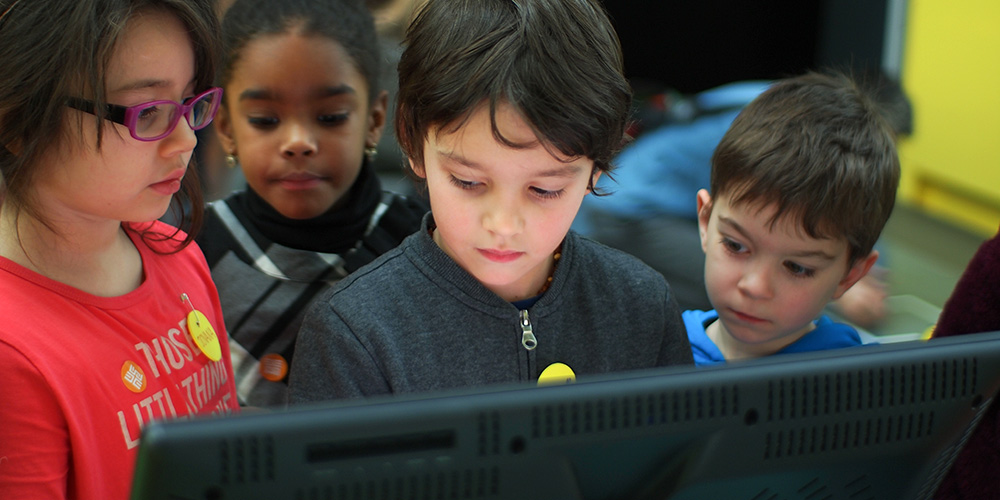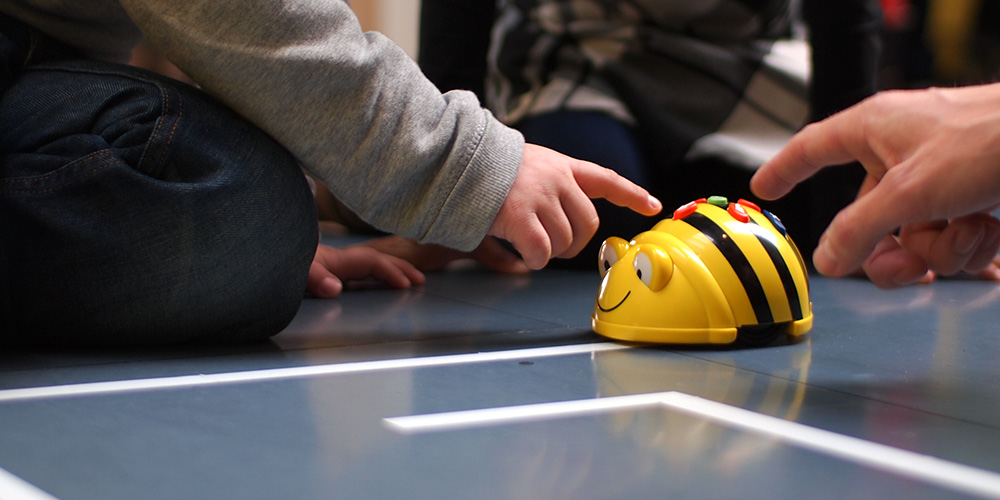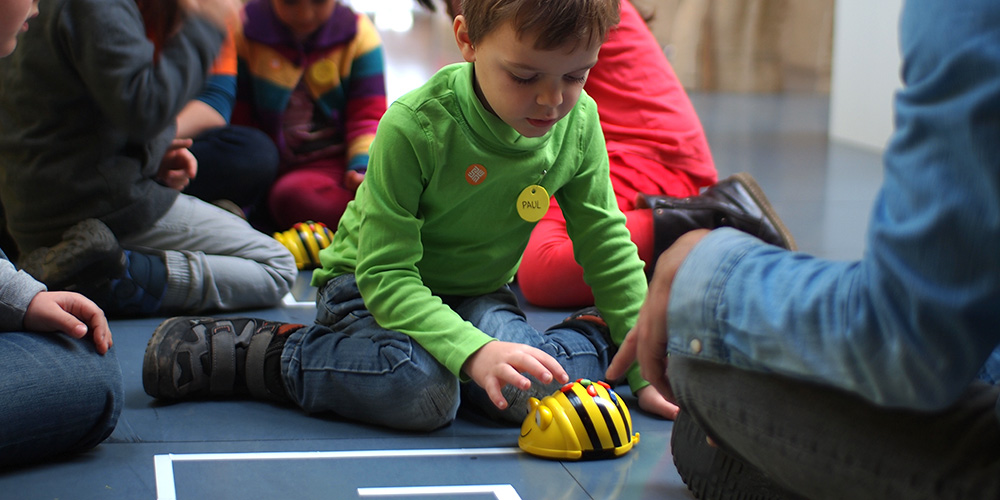The Kids’ Research Laboratory that opened in mid-January 2015 is the Museum of the Future’s high-tech playground for youngsters age 4-8. Nicole Grüneis of the Ars Electronica Center’s Education and Cultural Communication department was a member of the team that conceived the project. In this interview, she explains its pedagogical principles, which focus on active experimentation, discovery and, above all, play.
The Kids’ Research Laboratory was conceived for 4-8-year-olds. What makes the lab so fascinating for this age group?
Nicole Grüneis: Up to now, most of the offerings in our museum & school program targeted youngsters age 6 and up. In fact, if you consider what other museums—in Austria and elsewhere in Europe too—have been doing, then you see that young people’s first contacts with technical and scientific topics don’t occur until they begin attending elementary school. Nevertheless, kids nowadays start encountering high tech and new media at a relatively early age, so I think it’s a good idea to get them started with a bit of an introduction and some training in the preschool phase. But, of course, the approach has to be totally different. The tactile properties of these installations, their appearance and the mode of dealing with them have to be custom-tailored to the needs of kindergarteners, and I believe it’s essential for this contact to commence prior to school enrollment.
Why have you set up this bridge to the “Device Art” exhibition?
Nicole Grüneis: A year ago, we collaborated with OTELO on a temporary exhibition for 4-8-year-olds. “Kids Experience Technology” was a stand-alone exhibition situated primarily in the Center’s Lobby and thus without a segue to the AEC’s other exhibits and labs. So with the subsequent decision to conceive, design and organize this ourselves, a point high on our agenda has been to implement strong connections from the topics treated in the Kids’ Research Laboratory to our other themes. We knew right from the start that we didn’t want just a conventional guided tour format; a multi-installation “playground” setting was the idea from the very inception. Kids in this age group need a sheltered space all to themselves. And two municipal agencies—Kindergarten of the Future and the Department of Children & Youth Services—signed off on this concept.

The Kids’ Research Laboratory prominently plays up Albert Einstein’s famous words: “Play is the highest form of research.”
Nicole Grüneis: This Einstein quote is an allusion to our key concept: homo ludens—exploring the world and acquiring insights via game playing. And we employ this same concept to mediate visitors’ encounters with the “Device Art” installation immediately adjacent to it. That’s why it’s an effective pairing. The point of “Device Art” is using playful recontextualizations of functions to reconfigure devices or deploy them in ways totally unforeseen by their makers. From our point of view, there’s a natural link between this fun way of dealing with high tech and children’s magical, creative, inspiration-driven worldview. This exhibition is thus a nice fit. Naturally, it was also quite a challenge to adapt “Device Art,” which was originally conceived for grown-ups, to make it suitable for kids. But this playful approach that children take is precisely what makes it easier for them to see what we’re trying to get across here, as compared to other exhibitions.
Two eyes are blinking at us even as we speak …
Nicole Grüneis: “Nikodamas” are a good example. They’re truly emblematic of Device Art and nicely bring in mitate, this form of Japanese humor whereby an object is endowed with characteristics that make it resemble something else, the upshot of which is puzzlement and estrangement, and this is precisely what produces the humorous element. You can apply the “Nikodamas” to an object like a chair, and the chair suddenly isn’t a chair anymore. Some people’s reaction is a preference to not even sit on it so they don’t disturb it by doing so. And when you explain this to grown-ups, then the result is to conduct them into a childlike—not naïve, but playful—and thus animistic worldview, so that it dovetails very well indeed with seeing things through the eyes of children.

What else is in store for visitors to the Kids’ Research Laboratory?
Nicole Grüneis: In addition to seven experimental installations, we stage specific activities in conjunction with the objects on display in the “Device Art” exhibition. For instance, we gave a lot of thought to how we would deal with a work entitled “Tateye,” a socially critical piece of concept art in which a pair of glasses “laser-writes” a tattoo onto the user’s retina as a means of modifying his/her worldview. It’s meant to show what a strong impact media make on us and how this substantially changes the way we view things. Initially, I asked myself how we could get this across to kids. After much brainstorming, we decided to expand the exhibit in the form of additional glasses—for example, one that delivers x-ray images, and one with a pink filter that lets you see the world through rose-colored glasses. Here, kids behold how you can change the picture simply by shifting your attention. And this is what makes it possible to even address the subject of seeing with youngsters. And then there’s an old pair of Deep Space glasses with dark blotches on the lenses representing blind spots. This, in turn, is a great lead-in to the “New Views of Humankind” permanent exhibition in which you can normally use a so-called Retina-Cam to inspect your own retina and see the blind spots that everyone has but simply doesn’t recognize. We believe we can see perfectly with our eyes, but it’s not quite that way because of these blind spots. And this is an example of a perfect way to address a subject and thus establish a smooth transition to other issues we deal with here.

Nicole Grüneis
There are also installations at which kids can experiment.
Nicole Grüneis: Exactly. For instance, just like in the BioLab, we have an incident light microscope here, and we request that teachers do some preparatory work prior to their group’s visit, to bring in material with them and give some thought to the topics they want to address—such as nature, the human body or technical devices—and kids can view them enlarged by 50x. What’s really fascinating are Cubelets, these modular robotic components. Here, kids can try out different things to see how complex sequences can be modified by interactions of tiny components. There are sensor cubes, motor cubes, battery cubes and ballast cubes. And each cube agglomeration engenders different characteristics depending on how the child has assembled it. Kids can also discover how the cubes have to be rotated so the robot cube configuration moves forward, and how simple modifications let them influence the system—to make it go in circles, in reverse or forward. In going about this, they learn to think systematically, whereby it’s not just one element that changes; there’s an impact on the whole system. And in doing so, they enjoy a complete, hands-on, tactile experience. The cubes stick together via magnets, so even if the kids aren’t yet ready to get into the subject of robotics, at least they can get a feel for magnetism. There are so many great possibilities here!

Careful, there seems to be a blinking robot bee crawling our way …
Nicole Grüneis: This BeeBot experimentation station is one of the kids’ favorites. The yellow robot bees can be programmed by the press of a button. In this space, we’ve applied patterns to the floor, but kids can use any forms they desire. By pressing the button on the bee the right number of times, kids learn how to issue commands to a machine—getting it to go forwards, sideways, backwards, and to move in circles. This is also an exercise in strategic thinking, which usually comes into play when you do programming. The Ars Electronica Center already offers other programming workshops for young people age 8 and up, but instead of entailing conventional computer software, that system is based on visual components that can be assembled by interlocking them. Nevertheless, this is still a bit too difficult for 4-year-olds. What they have here is the direct implementation of their commands by a physical object. And that’s the important thing for this age group—this transparency and the ability to draw cause-and-effect conclusions from that which transpires. In going about this, kids display tremendous concentration and perseverance. The BeeBots are also a great way to learn to estimate distance and to verbalize directions and motions. They’re also used in Information Science instruction to train youngsters to input commands and plan in advance. And this also works well with 4-year-olds.
When can visitors pay a call on the Kids’ Research Laboratory?
Nicole Grüneis: Kindergarten classes with kids age 4 and up, for example, can come by in the morning, and after-school care groups for youngsters up to 8 years of age can visit us in the afternoon. The first few weeks are reserved for municipal kindergartens associated with the city’s Department of Children & Youth Services. After that, all the other kindergartens and elementary schools are cordially invited to make reservations for a visit. On weekends or on weekdays around Noon or following the afternoon slots set aside for kindergartens, anyone can stop by—even if all the installations aren’t available as they would be in the case of a group reservation. We’ve also noticed that adults get a kick out of this stuff too and have a ball in the Kids’ Research Laboratory. The “downsizing” of the furniture doesn’t seem to bother them one bit!
Note: More info about the Kids’ Research Laboratory is available at ars.electronica.art/center/en/kinderforschungslabor.
